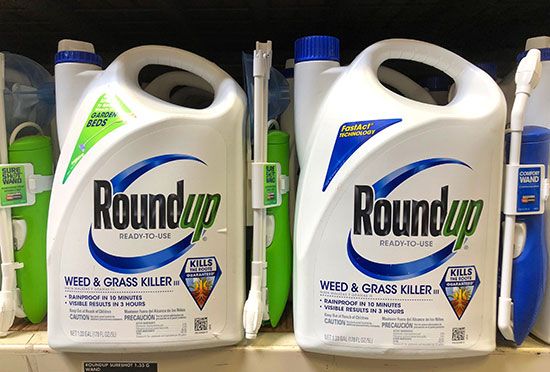glyphosate
- Also called:
- N-(phosphonomethyl)glycine
News •
glyphosate, herbicide used to control grasses and broad-leaved weeds. Glyphosate is highly effective in managing noxious weeds and is widely used in the production of fruits, grains, nuts, and vegetables. It is the active ingredient in various commercial weed-killing formulations, including those sold under the brand names Roundup, Rodeo, Eraser, Refuge, AquaMaster, and AquaPro.
Discovery and development
Glyphosate was initially synthesized in 1950 during a search for novel pharmaceutical compounds carried out by chemist Henri Martin at the Swiss company Cilag. The compound was set aside, however, owing to a lack of evidence for pharmaceutical potential. In the 1960s, following the acquisition of Cilag by the American company Aldrich Chemical, glyphosate was added to the Aldrich Library of Rare Chemicals. This led to its rediscovery and, in 1970, its resynthesis by chemists Phil Hamm and John Franz, who were working for the American company Monsanto; their work resulted in the identification of the herbicidal activity of glyphosate. In 1974 Monsanto introduced Roundup, the first glyphosate-based herbicide; Roundup quickly became a leading herbicide product worldwide.
Uses, mechanism of action, and resistance
Glyphosate has played a central role in agriculture since its introduction. In the late 1970s and ’80s, for example, it gave impetus to low-till and no-till farming, allowing for more timely crop establishment and improved crop yields; these approaches further aided the retention of soil moisture and helped reduce soil erosion, particularly in arid and semiarid environments. Beginning in 1996 with the development of genetically engineered glyphosate-resistant crops, the herbicide’s use in agriculture increased dramatically; such engineered crops include varieties of canola (rapeseed), corn, cotton, and soybeans. Other uses of glyphosate are focused on bare-ground weed control, such as in orchards and vineyards, in fallow fields, along fence lines, and on lawns and gardens. It is also often used to control weeds in aquatic environments, particularly cattails (Typha), reed canary grass (Phalaris arundinacea), purple loosestrife (Lythrum salicaria), and common reed (Phragmites), which grow near water and are considered invasive in many areas.
The herbicidal actions of glyphosate result from its inhibition of an enzyme known as EPSP synthase, which regulates the synthesis of the aromatic amino acids via the so-called shikimic acid pathway. Aromatic amino acids include phenylalanine, tryptophan, and tyrosine, which are necessary for the synthesis of proteins involved in plant growth. Glyphosate further disrupts the synthesis of nonaromatic amino acids via additional mechanisms and causes the accumulation of shikimate, a substrate of EPSP synthase. Thus, inhibition of EPSP synthase prevents plants from producing amino acids and proteins required for growth and has other toxic effects. These actions are nonselective in terms of plant species, and therefore glyphosate is toxic to most plants following contact with foliage.
Some species of plants are naturally tolerant to glyphosate; examples include field horsetail (Equisetum arvense), yellow nutsedge (Cyperus esculentus), and wild buckwheat (Fallopia convolvulus). In other instances plants develop resistance to glyphosate after repeated exposure. Glyphosate resistance has been documented in at least several dozen species of plants worldwide. The mechanisms underlying resistance vary; examples include genetic mutation that leads to overexpression of EPSP synthase, mutation that prevents herbicide interaction with EPSP synthase, and mutation that results in decreased herbicide uptake and retention. Plants that have been engineered to resist glyphosate carry a gene that encodes a version of EPSP synthase from bacteria that is insensitive to glyphosate. Gene flow from plants engineered for glyphosate resistance to wild plants can occur via pollen and seed and is a cause of concern for the environment and human health.
Environmental and health impacts
Concerns about impacts to the environment and human health resulted in extensive reevaluation of the chemical’s safety and use. Many concerns about human health stemmed from a 2015 report by the World Health Organization (WHO) International Agency for Research on Cancer (IARC), which concluded that glyphosate is “probably carcinogenic.” In 2020, following extensive evaluation by the U.S. Environmental Protection Agency (EPA), the risk to human health from glyphosate was concluded to be very low, with no likely threat of cancer when products were used according to manufacturer’s instructions. Nonetheless, in the 2010s numerous lawsuits claiming that Roundup caused cancer were filed against Monsanto. In 2018 the German chemical and pharmaceutical company Bayer acquired Monsanto; shortly thereafter the first Roundup lawsuit was decided in favour of the plaintiff. In 2020 Bayer agreed to pay more than $10 billion to settle claims regarding Roundup.
Risks to nontarget plants from glyphosate use, particularly through spray drift, are well documented. Mitigation measures to minimize such risks have included changes in product labeling to more clearly explain the management of spray drift and ways to prevent herbicide resistance. Analysis of other ecological risks, including impacts to monarch butterfly habitat, outcrossing from engineered plants, and potential actions as an endocrine disruptor, is ongoing. Despite a lack of scientific evidence to support claims against glyphosate use, the perceived risks and potential impacts to human health, including yet unknown effects on reproduction and neurological function—in addition to environmental risks—have led some countries and cities to ban or otherwise restrict the use of glyphosate.











